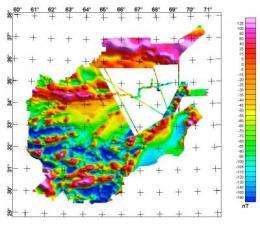Aerogeophysical survey provides promising prospects of economic development in Afghanistan

Analyzing nearly 20 terabytes of data collected from 220 mission flight-hours covering more than half of Afghanistan, Naval Research Laboratory and the U.S. Geological Survey investigators reveal several potential major oil and gas sedimentary basins, mineral-rich regions, and hydrologic resources for agriculture and economic development as recently reported by Department of Defense.
Flights administered by Naval Research Laboratory Scientific Development Squadron One (VXS-1) were flown using NP-3D Orion turboprop aircraft specially equipped with a suite of unique state of the art remote sensing technology that included dual gravimeters, scalar and vector magnetometers, a digital photogrammetric camera, hyperspectral imager and an L-band polarimetric synthetic aperture radar.
Photogrammetric mosaics and other imagery processed by USGS have also been provided to the National Geospatial-Intelligence Agency (NGA) for incorporation into Department of Defense image libraries and are being used for economic analysis projects by the United States Agency for International Development (USAID) for construction and development projects and to the government of Afghanistan for a myriad of uses to include geologic exploration, hydrologic resource management and earthquake hazard analysis.
"This imagery will be enormously important for seismic and flood hazard analysis, development of roads, pipelines and property boundaries, and other civil infrastructure projects and agriculture resource management," states NRL Chief Scientist, Dr. John Brozena. "The data we have amassed and are analyzing today could prove invaluable to the future economic redevelopment of Afghanistan," added Brozena.
The country faces dual challenges of suppressing Taliban and al-Qaeda operations and developing the basis of a legal and sustainable economy that minimizes popular support for terrorist activity. The combined efforts of NRL, USGS, and the crew of VXS-1 to conduct a major airborne remote sensing and mapping project contribute greatly to both these objectives.
Provided by Naval Research Laboratory
















